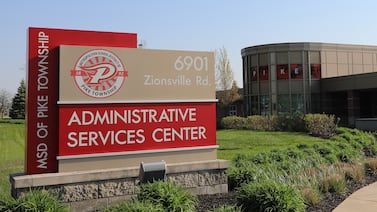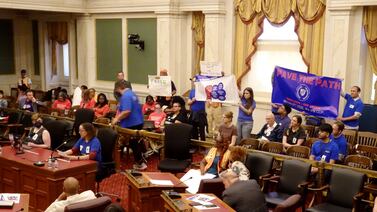Rudyard Area Schools, a district in Michigan’s Upper Peninsula, has just one school building to serve its entire K-12 enrollment of 627 students. And that building is about a 23-mile bus ride away from Trout Lake, a town of 330 people on the other side of the district.
Those daily school bus trips require a lot of fuel. Low student density across the district’s 400 square miles helps explain why Rudyard spends more money on transportation per student than all but a handful of Michigan districts — about $1,000, or 7% of its total budget.
But despite its outsize transportation costs, Rudyard receives little extra funding help to get students to school. And many other districts, especially in sparsely populated areas, also face the burden of busing costs that eat into funds for instruction and facilities.
A new report offers a way to change that, drawing on transportation funding models from other states to propose a fix for what education leaders say is a longstanding hole in Michigan’s school funding system.
Carrying out the proposal wouldn’t be cheap, and it would have to find space in the new Democratic majority’s already crowded legislative agenda.
But advocates say it could have a powerful impact on education by improving attendance and freeing up operating funds for instruction and other priorities.
As it stands, districts with higher transportation costs — particularly in sparsely populated rural areas — wind up diverting money from the classroom to cover those costs. The state has no funding stream dedicated to the costs of school transportation, and its school funding system doesn’t account for transportation cost differences among districts, says Wanda Cook-Robinson, superintendent of Oakland Schools, a county educational service agency in metropolitan Detroit, who is part of the group that issued the report.
School funding study lacked focus on transportation
The report came from the School Finance Research Collaborative, a nonpartisan education research group that commissioned a detailed assessment of the actual costs of providing a high quality education to Michigan students. That study was released in 2018 and updated last year.
The SFRC assessment has become a sort of blueprint for policymakers seeking to increase education funding in Michigan. It emphasizes providing additional funding for students who are most expensive to educate, such as English learners.
But until now, the study lacked any discussion of how to fund transportation, which accounted for about 3% of school spending last year.
“I’m hopeful that (the new report is) a step in the right direction,” said Tom McKee, superintendent of Rudyard Area Schools. “It’s one of the things we wish came out of the report originally.”
Transportation costs are among the most pressing concerns of Michigan’s rural superintendents, according to a recent report from Michigan State University.
Funding formula would group districts by density
The SFRC transportation report was put together by an education consulting group, Augenblick, Palaich, and Associates. To develop their recommendations, researchers reviewed transportation funding policies from every U.S. state, narrowing the list down to models they felt would work best in Michigan.
Their final recommendation centers on districts’ student density, as measured by bus riders per square mile. Districts would be grouped by density. Then, to encourage efficient spending, they would receive funding equal to the average transportation spending for districts in their group.
Here’s an example provided by the SFRC: Say a district that currently spends $848 per rider on busing is in a density group with districts that spend an average of $927 per rider. That district would receive full reimbursement of its current transportation costs. Meanwhile, a district in the same density group that spends $2,774 per rider would be reimbursed up to the group average: $927 per rider.
Implementing the plan would be costly: The consulting group hired to conduct the study pegged the cost at $402 million per year, which would amount to a 2% increase in the overall schools budget.
But the added spending could pay off in the classroom by, for example, helping to address the high rates of chronic absenteeism that have set off alarm bells for state and local leaders this year.
A study of school transportation systems in 50 large Michigan districts this year found that attendance rates increased by as much as 1 percentage point when economically disadvantaged families had access to a school bus.
Even if districts didn’t use the added funding to expand their transportation offerings, “providing funding for transportation will allow districts to spend the money they would otherwise spend on school transportation in the classroom or on other interventions that could increase attendance or test scores,” said study author Danielle Edwards, an education researcher at Brown University.
As Democrats take full control of the levers of power in Lansing for the first time in decades, they will likely look to the SFRC to guide their education spending proposals.
State Sen. Rosemary Bayer, D-Beverly Hills, said the new leadership’s priorities are still being negotiated. But she thinks transportation funding is important.
“It’s such a direct and obvious way to deal with our attendance problem,” she said. “Just pick the kids up and take them to school.”
Gov. Gretchen Whitmer’s budget recommendation, viewed as a key signal of the Democrats’ education spending plans, is slated for a February release.
Koby Levin is a reporter for Chalkbeat Detroit covering K-12 schools and early childhood education. Contact Koby at klevin@chalkbeat.org.
Correction: Dec. 9, 2022: A previous version of this story said that Danielle Edwards’ transportation study is about Detroit; in fact, the Detroit Public Schools Community District is excluded from her analysis of attendance rates.








